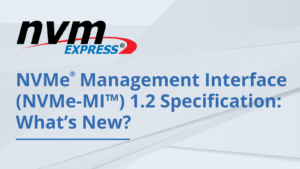
NVMe® Management Interface (NVMe-MI™) 1.2 Specification: What’s New?
BlogBy Austin Bolen, Distinguished Engineer, Server Storage at Dell EMC
To evolve with the next phase of NVM Express® (NVMe®) technology, the NVMe Management Interface (NVMe-MI™) specification was modified to optimize NVMe SSD management and ensure interoperability with the other specifications. These changes have been released in the NVMe-MI 1.2 specification, which is available in the newly released NVMe 2.0 specifications family. In this blog, I will discuss the purpose of the NVMe-MI specification, the new changes to this specification, and provide an overview of the various markets this specification supports.
What is the NVMe-MI Specification?
The NVMe-MI specification provides an industry standard way to manage NVMe devices out-of-band and independent of the host operating system (usually through a BMC, or baseboard management controller). This allows system makers to provide a consistent way to manage NVMe devices, regardless of which host operating system the user is running.
Management operations supported by NVMe-MI architecture allow the user to control the full lifecycle of NVMe devices by providing the ability to discover, monitor, configure, and update NVMe devices.
NVMe-MI 1.2 Specification Overview
The NVMe-MI 1.1 specification added several major architectural changes such as Enclosure Management, the ability to issue management commands to an NVMe device in-band from the host operating system that previously only allowed out-of-band, carrier card expansions and more. You can learn more about the NVMe-MI 1.1 specification features by reading “NVMe-MI™ 1.1: Why Manageability is Critical for Today’s Enterprise Storage Demands.”
For the NVMe-MI 1.2 specification, we evolved the interface to better optimize existing use cases and make them more efficient and resilient from lessons learned from using the interface over the years. We also added new security features like the ability to lock down command execution to prevent unintended or malicious changes to NVMe devices. And finally, we made some structural changes to the specification to align with the refactoring efforts that were completed for the NVMe 2.0 library of specifications.
Market Impact
Historically, the NVMe-MI specification has been focused on enterprise applications, including asset management, temperature monitoring, change management, health monitoring, and more.
We are now seeing interest in NVMe-MI technology from other market segments like client and hyperscale. A new client use case includes added support of the NIST standard for Firmware Resiliency (NIST SP800-193) by enabling recovery from a corrupted system BIOS image. A new hyperscale use case includes debug and triage of NVMe devices when the in-band interface to the host operating system is unresponsive.
As NVMe-MI technology matures and usage increases, we will continue to make updates to support new and emerging markets.
Learn More
Recently, I discussed the NVMe-MI specification and what it means for the industry at large. I invite you to watch my video interview today. You can also access the NVMe-MI 1.2 specification on the NVM Express website.
View the series of NVMe 2.0 specifications videos on our YouTube Channel to learn more about the latest features and how this technology will revolutionize various markets.